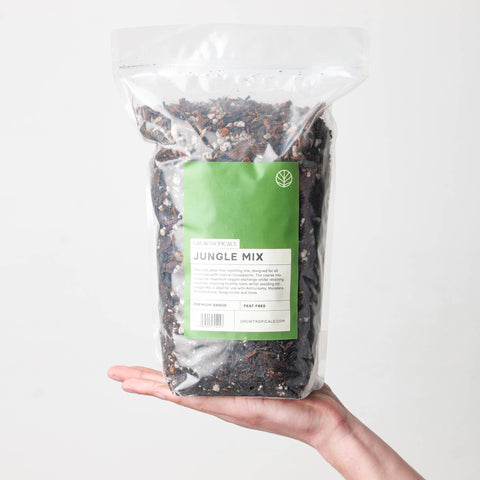One question we get asked (almost) daily is how do I know when my houseplant is ready for a repot? It's an age-old question and, unfortunately, isn't a one-size-fits-all answer. Luckily for you, Spring and Summer months are a great time to repot your houseplant without causing it too much stress.
To help you identify whether your plant is in need of a repot, we've listed below five top tips below.
The Soil Dries Out Very Fast
One of the tell-tale signs that your houseplant is outgrowing its pot is when the soil dries out fast. If you find yourself picking up the watering can far more frequently than usual, it might be time to consider repotting. A bigger pot with new soil will provide better moisture retention, ensuring your plant stays hydrated and healthy.
If you're repotting a tall or climbing houseplants, be sure to provide a good support, structure in the pot for your plant such as a moss pole, kratiste pole or trellis. This will give your plant a helping hand and encourage healthy growth. It'll also prevent top-heavy plants from toppling over.
There's More Roots in the Pot Than Soil!
Carefully pop your plant out of it's nursery pot and check the roots. If you notice a dense network of roots circling the pot's bottom or poking out from the drainage holes, your plant has likely outgrown its current home. When roots become root-bound, they can't absorb water and nutrients effectively, stunting your plant's growth. Repotting into a nursery pot 1 to 2 inches bigger will give the roots more room to spread out and thrive, without shocking the plant. We always suggest repotting plants into a clear plastic pot with good drainage holes as it allows you to easily check in on the roots from time to time with minimal disturbance.
The Plant Has Been in the Same Pot for Multiple Years
Has it been a while since you last repotted your plant? If it's been over 3 years and your plant hasn't shown signs of growth or seems to be struggling, it's probably time for an upgrade. Over time, soil loses its nutrients, and the potting mix becomes compacted, making it harder for your plant to flourish. Refreshing the soil and providing fresh nutrients through repotting can rejuvenate your plant and encourage healthy new growth.
There is Very Little New Growth Over Long Periods of Time
If you've noticed that your plant has been stagnant in terms of growth, despite your best efforts in caring for it, it might be a sign that it's craving more space. Lack of growth can indicate that the plant has exhausted the nutrients available in its current soil and needs to be repotted into fresh, nutrient-rich soil to thrive.
the soil Has become Hydrophobic and/or Pulls Away from the Container Edge
Hydrophobic soil, which repels water instead of absorbing it, is a common issue in overgrown pots. How can you tell if your soil is hydrophobic? Look out for these signs:
- Water beads up on the soil surface instead of being absorbed.
- When you water your plants, the water quickly drains through the soil without moistening it.
- The soil appears dry and crumbly, even after watering.
With such a compact soil structure, it's important to be careful when tugging the roots away from the soil during a repot.
time for a repot?
If it's time for you to get your hands dirty, fear not! We have everything you need for an easy repotting process. From specialist houseplant soil to plant foods, be sure to check out our plant care collection for all of your repotting needs.

GrowTropical's Jungle Mix - Houseplant Potting Mix from £4.99
Happy repotting!






Leave a comment